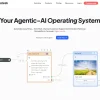أدوات الذكاء الاصطناعي الأخرى
Asana has successfully transformed from a sleek task manager into an AI-powered operating system that aligns daily execution with long-term strategy.
Goals & Reporting – Connecting Daily Tasks to Strategic Outcomes
Traditional project tools track “what” teams are doing; Asana links every task to the “why.” Users can set multilevel Objectives & Key Results (OKRs) that automatically roll up progress from underlying projects. AI highlights risks such as a KR trending off-track three weeks before the quarter ends, suggesting mitigation actions like re-allocating headcount or tightening scope.Asana AI – A Contextual Co-Worker
The AI layer surfaces in three primary interfaces:- Smart Goals: When a manager types “launch new loyalty program by Q4,” Asana AI generates a nested goal hierarchy with recommended milestones, owners, and due dates based on historical velocity of similar programs.
- Smart Status: Instead of manual check-ins, teams receive AI-drafted status updates that summarize blockers, scope changes, and priority shifts across all connected projects.
- Smart Rules: Users can create no-code automations in plain English—e.g., “If a task tagged ‘Urgent’ sits unassigned for more than two hours, add it to the triage project and ping the on-call engineer.” The system translates the sentence into executable logic without a single line of code.
أضف إلى المفضلة
الإبلاغ عن إساءة
الإبلاغ عن إساءة
لقد تم إرسال تقريرك إلى المسؤول.
القوائم المميزة
{{props.swiper.activeIndex + 1 }} / 6
المزيد من هذا المستخدم
قد يعجبك أيضاً...

دليل أدوات الذكاء الاصطناعي
أحدث القوائم
جميع الحقوق محفوظة © ٢٠٢٥ CogAINav.com.






















